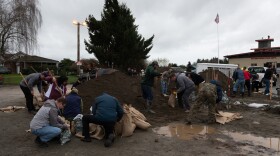Winter winds and ocean currents are expected to deposit more debris on the Washington coast from the March 2011 tsunami in Japan.
State Ecology Department spokeswoman Linda Kent says the amount of debris declined over the summer after peaking in June, but it could pick up as weather patterns shift.
KPLU weather expert Cliff Mass said he expects a “neutral winter”:
“But neutral or La Nada winters are also the ones where the rare big storms occur. Not sure there is much implication of big storms for tsunami debris movement, which I assume is dependent on the large scale and long term wind, current, and wave distributions.”
This video from summer’s peek tsunami month gives a good indication of beaches could look like this winter:
http://www.youtube.com/watch?v=yPelZ5fhjGI
Washington plans call for volunteers to dispose of small items like plastic foam they find while beachcombing.
The Ecology Department and Coast Guard will respond to potentially hazardous materials such gas cans and oil drums. Kent says the department handled 10 such items in the first six months this year.


State plan
Key goals identified in the Washington State Marine Debris Response Plan (each goal is followed in the document with specific response actions the state will take or require):
- Remove routine and small non-hazardous debris items to eliminate environmental and safety risks, and the economic impact. Minimize impacts to threatened and endangered species, migratory birds, and their habitats.
- Address large marine debris items to eliminate environmental and safety risks and impediments to beach use.
- Remove and dispose of hazardous and potentially hazardous items (such as spilled oil, fuel tanks and containers, drums, gas cylinders, chemical totes, and other containers) that may hold oil and other petroleum products or be filled with hazardous materials, including potential radioactive hazards.
- Address large debris items at sea that may pose a threat to navigation or a pollution risk.
- To recruit, train, coordinate and assign volunteer groups to specific cleanup tasks as requested.
- Respond to reports of sizeable marine debris with living organisms to evaluate, identify, contain, and eradicate aquatic invasive species (AIS) before they can impact native ecosystems.
- Provide the first and best source of information about Japanese tsunami marine debris and its impacts on the Washington State coast. This includes providing effective risk-management communications and equipping citizens and stakeholders with the information they need to address issues associated with potential debris, including risks to human safety and spread of invasive species.
(Once you get through the commercial, this video shows the extent of the debris:)
Upcoming meetings
The state Marine Debris Task Force is holding three community meetings on response plans on Nov. 7 in Port Angeles, Nov. 15 in Ocean Shores and Dec. 6 in Long Beach.
For more information:
- Washington Marine Debris web portal
- NOAA
- Joint States tsunami debris information website
- Washington Emergency Management Division
- Washington Department of Health
- Washington Department of Fish and Wildlife
- Washington Department of Ecology
- Washington State Parks and Recreation Commission
- Washington State Conservation and Recreation Office







